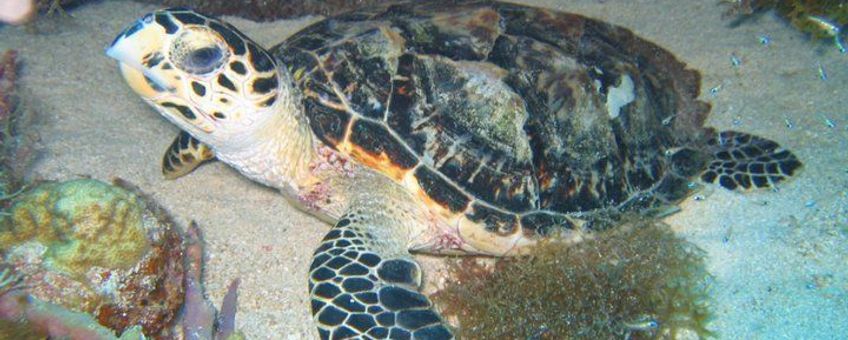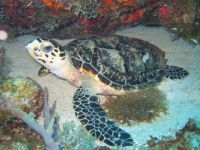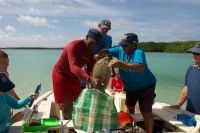
Zeeschildpaddenseizoen in de Caraiben
Bericht uitgegeven door Dutch Caribbean Nature Alliance (DCNA) op [publicatiedatum]
Eind maart begon het broedseizoen van de zeeschildpadden in het Caraïbisch gebied. Deze reptielen worden wereldwijd met uitsterven bedreigd door de ontwikkeling van kustgebieden, bijvangst en verontreiniging van het oceaanwater, maar spelen een belangrijke rol in oceanen en strand en duinen.
 In de oceanen zijn zeeschildpadden één van de weinige diersoorten die zeegras eten. Het zeegras moet kort gehouden worden om gezond te blijven en gezond zeegras is essentieel voor de voortplanting en ontwikkeling van veel vissen en ander zeeleven. Strand en duinen zijn afhankelijk van vegetatie om ze tegen erosie te beschermen. Eieren en jonge schildpadjes die het niet redden tot het oceaanwater zijn een belangrijke voedselbron voor de vegetatie op het strand en in de duinen. En elk jaar leggen zeeschildpadden ontelbaar veel eieren op de stranden.
In de oceanen zijn zeeschildpadden één van de weinige diersoorten die zeegras eten. Het zeegras moet kort gehouden worden om gezond te blijven en gezond zeegras is essentieel voor de voortplanting en ontwikkeling van veel vissen en ander zeeleven. Strand en duinen zijn afhankelijk van vegetatie om ze tegen erosie te beschermen. Eieren en jonge schildpadjes die het niet redden tot het oceaanwater zijn een belangrijke voedselbron voor de vegetatie op het strand en in de duinen. En elk jaar leggen zeeschildpadden ontelbaar veel eieren op de stranden.
De rest van dit Natuurbericht is in het Engels. Hieronder een lijstje Nederlandse namen van zeeschildpadden en andere soorten die in het Engelstalige deel genoemd worden:
Hawksbill turtle – Karetschildpad
Leatherback – Lederschildpad
Green sea turtle – Groene zeeschildpad
Manatee - Zeekoe
Lees verder in het Engels...
Did you know that sea turtles have lived in the world’s oceans for more than 150 million years? To put that in context, humans have been around for roughly 200,000 years, about .013 percent of the time sea turtles have been here.
Sadly these ancient marine reptiles that inhabit all of the world’s oceans except the Arctic are globally threatened with extinction (Hawksbill and Leatherbacks are Critically Endangered) – a result of persistent coastal development, incidental capture and marine pollution. This decline has been evident throughout the Caribbean and in some areas the trends are dramatic and likely to be irreversible in our lifetime. Because sea turtles are among the most migratory of all Caribbean animals, what appears as a decline in a local population may be a direct consequence of activities of people hundreds of kilometers away and thus presents a call to not only local conservation, but also regional partnership.
Sea turtle populations, which remain robust in many areas of the Dutch Caribbean, are stressed for many reasons. A major consideration is the destruction and/or modification of habitat. Many nesting beaches have disappeared due to sand mining and development of the coast. Beach trampling by tourists and disorienting light from nearshore buildings have a serious impact on nesting females and hatchings attempting to find the sea.
Pollution from both land-based and marine sources (eg. sewage, plastic, oil) is an increasing problem for sea turtles. The degradation of our coral reef system has also taken its toll on the turtles foraging grounds and while uncontrolled harvesting of turtles has seen policy improvement in the past decade, there are still areas that allow harvesting or do not have the enforcement abilities to adequately protect these endangered species.

Visit Sea Turtle Conservation Bonaire (STCB) to see what is being done to protect sea turtles and how you can do your part for nature in the the Dutch Caribbean.
Sea turtles play key roles in two ecosystem types that are critical to them as well as to humans—oceans and beaches/dunes. In the oceans, for example, sea turtles, especially green sea turtles, are one of very few creatures (manatees are another) that eat the sea grass that grows on the sea floor. Sea grass must be kept short to remain healthy, and beds of healthy sea grass are essential breeding and development areas for many species of fish and other marine life. A decline or loss of sea grass beds would damage these populations, triggering a chain reaction and negatively impacting marine and human life.
Beaches and dunes form a fragile ecosystem that depends on vegetation to protect against erosion. Eggs, hatched or unhatched, and hatchlings that fail to make it into the ocean are nutrient sources for dune vegetation. Every year, sea turtles lay countless eggs on beaches.
Tekst en foto karetschildpad: Dutch Caribbean Nature Alliance
Foto wegen zeeschildpad: Sea Turtle Conservation Bonaire
Nederlandse introductie: Wichertje Bron, Natuurbericht.nl
